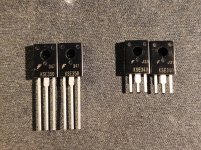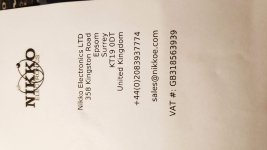Hi, I ve buy from littlediode (UK eBay seller) 2sk389 mosfet
I ve install on my audiolab 8000p and he blow my output stage.
It's a fake jfet???
I had from littlediode fakes in past, big mosfets 15 amps 200 volts seems to be 5 amp 40 volts and blow the amp.
so do not buy there,
LittleDiode are getting some really awful reviews here. It appears that they are buying from anywhere without checking if the parts are genuine.
This was the answer I get from them, saying we are just sellers, but I have told, please check them very good before buying them in, it wil destroy your name.
did not help I see.
Last edited:
If you are buying really rare components you might be better buying pulled parts. The Chinese are even faking £3.50 op-amps.
I'd be very surprised if they stooped so low as to re-mark pulled components. (I wouldn't put it past them though).
Even with pulled parts, it is not shure you get the good ones, I did buy a tester for transistors caps etc, and seems not working after received it, reason, fake components are in there, I did had to replace comparator on board, then it did work again.
Chinese want leadership in economics, then she need to do something about this fake sellers.
Is there a way to put trustable sellers online here to see who we need to have buying from. Maybe a idea.

Hi kees52,
There is no way to guarantee a "good seller" and DIYAudio cannot take responsibility for vendors. That is what in effect we would be doing. The Store does everything in it's power to make sure the parts you buy are real ones. But don't expect to get old, discontinued parts from the store.
Some members had stockpiled various parts and will occasionally sell some off. Again, it comes down to buyer beware.

Hi, I ve buy from littlediode (UK eBay seller) 2sk389 mosfet
I ve install on my audiolab 8000p and he blow my output stage.
It's a fake jfet???
I've had a fake 2SK389 which was actually a dual NPN bipolar transistor.
How you solve the replacement?
I've had a fake 2SK389 which was actually a dual NPN bipolar transistor.
Hi Mazxo85,
A fake or bad 2SK389 (a dual J-FET, N-channel) may have caused a big DC offset, but probably did not cause your output stage to blow directly. Why did you replace that part to begin with?
-Chris
It s a Doble transistor... Not jfet... Total different!
How you solve the replacement?
I used two 2SK369 instead of one 2SK389.
It s a Doble transistor... Not jfet... Total different!
A JFET is a transistor, too
Hi Mazxo85,
I am absolutely certain of what this part is, having used buckets of them. It is a pair (two) N-channel JFET transistors in one SIP package. The two transistors are matched, which is why they are in the same package. They are not PNP, they are not NPN.
Please look the part up before commenting.
Also, it is highly unlikely that a bad 2SK389 blew the outputs in your amplifier. You may have done something since you don't seem to understand what parts you are dealing with. The 2SK389 you have might be perfectly fine. You haven't even mentioned why you replaced the diff pair in the first place. What made you think this part was bad to begin with?
-Chris
I am absolutely certain of what this part is, having used buckets of them. It is a pair (two) N-channel JFET transistors in one SIP package. The two transistors are matched, which is why they are in the same package. They are not PNP, they are not NPN.
Please look the part up before commenting.
Also, it is highly unlikely that a bad 2SK389 blew the outputs in your amplifier. You may have done something since you don't seem to understand what parts you are dealing with. The 2SK389 you have might be perfectly fine. You haven't even mentioned why you replaced the diff pair in the first place. What made you think this part was bad to begin with?
-Chris
I was changing for hiss noise from 1 channel.... I inverter original left and right channel 2sk389 and noise follow the transistor.
Then I install fake 2sk389v and blow my output stage.
I test 2sk389v whit mosfet tester and is a bjt npn transistor.... Not a jfet!
Then I install fake 2sk389v and blow my output stage.
I test 2sk389v whit mosfet tester and is a bjt npn transistor.... Not a jfet!
An externally hosted image should be here but it was not working when we last tested it.
Hi Mazxo85,
I am absolutely certain of what this part is, having used buckets of them. It is a pair (two) N-channel JFET transistors in one SIP package. The two transistors are matched, which is why they are in the same package. They are not PNP, they are not NPN.
Please look the part up before commenting.
Also, it is highly unlikely that a bad 2SK389 blew the outputs in your amplifier. You may have done something since you don't seem to understand what parts you are dealing with. The 2SK389 you have might be perfectly fine. You haven't even mentioned why you replaced the diff pair in the first place. What made you think this part was bad to begin with?
-Chris
Hi Mazxo85,
Then you most definitely have a fake part! The original is a dual J-Fet. 2SJ and 2SK numbered parts are always Fets of some kind. 2SA through 2SD are always BJT transistors. There are no exceptions to that rule.
-Chris
OK but I say that NPN transistor is different from.Jfet and this is why it blown my amp...
Hi Mazxo85,
That would not normally blow the outputs immediately. If you had increased current, the fuse should have blown instead before the parts overheated. Most times you would simply get a high DC offset at the output since the diff pair is in the voltage amplifier stage. The output stage is a current amplifier.
When doing amplifier service, powering it up after the parts were replaced, you would normally disconnect the load (especially) and "soft start" the amplifier using a variac. You would increase the AC voltage slowly while watching current draw and output voltage as you increase the AC voltage. No damage would have occurred if the start procedure was followed. I'm also in the habit of testing new parts before I install them. It's not worth troubleshooting a bad new part that takes a very short time to test before installation.
I don't think the bad part directly damaged the output stage. If you just fired it up connected to speakers, you may have lost a woofer as well. That amplifier can deliver a lot of current in a fault mode.
-Chris
That would not normally blow the outputs immediately. If you had increased current, the fuse should have blown instead before the parts overheated. Most times you would simply get a high DC offset at the output since the diff pair is in the voltage amplifier stage. The output stage is a current amplifier.
When doing amplifier service, powering it up after the parts were replaced, you would normally disconnect the load (especially) and "soft start" the amplifier using a variac. You would increase the AC voltage slowly while watching current draw and output voltage as you increase the AC voltage. No damage would have occurred if the start procedure was followed. I'm also in the habit of testing new parts before I install them. It's not worth troubleshooting a bad new part that takes a very short time to test before installation.
I don't think the bad part directly damaged the output stage. If you just fired it up connected to speakers, you may have lost a woofer as well. That amplifier can deliver a lot of current in a fault mode.
-Chris
No speaker connected, only power cord.
I have not use a variac, but it not true that when you change a component it can burn if you not use a variac.
Before change 2sk389 amp was full working....
After install I switch on and rele does t click, after 10 sec I power off but 1 output transistor have blown, and 1 fuse was blown....
I have not use a variac, but it not true that when you change a component it can burn if you not use a variac.
Before change 2sk389 amp was full working....
After install I switch on and rele does t click, after 10 sec I power off but 1 output transistor have blown, and 1 fuse was blown....
Hi Mazxo85,
That would not normally blow the outputs immediately. If you had increased current, the fuse should have blown instead before the parts overheated. Most times you would simply get a high DC offset at the output since the diff pair is in the voltage amplifier stage. The output stage is a current amplifier.
When doing amplifier service, powering it up after the parts were replaced, you would normally disconnect the load (especially) and "soft start" the amplifier using a variac. You would increase the AC voltage slowly while watching current draw and output voltage as you increase the AC voltage. No damage would have occurred if the start procedure was followed. I'm also in the habit of testing new parts before I install them. It's not worth troubleshooting a bad new part that takes a very short time to test before installation.
I don't think the bad part directly damaged the output stage. If you just fired it up connected to speakers, you may have lost a woofer as well. That amplifier can deliver a lot of current in a fault mode.
-Chris
Last edited:
Fake ksa340 / 350 ?
I have recently bought Fairchild KSE340/350 from Nikko Electronics UK. I have been warned those look fake. Those 340s came short leged but under a magnifier, they look like factory cut. There is zink on the bottom. Has anyone seen such cut legs from factory?!?!
Any opinions, perhaps measurements that would help to compare?
I have recently bought Fairchild KSE340/350 from Nikko Electronics UK. I have been warned those look fake. Those 340s came short leged but under a magnifier, they look like factory cut. There is zink on the bottom. Has anyone seen such cut legs from factory?!?!
Any opinions, perhaps measurements that would help to compare?
Attachments
Interesting. Datasheet only specifies full length pins.
But usually they can be ordered bent/cut according to customer needs. So it would be a custom ordered batch then.
But then the date code, it is not mentioned in the datasheet, but Fairchild/On-semi should be YWW, and also somewhere it says that Y is last digit of year. In that case J is not a valid year
Also the date code is very far to the right side...almost too close to edge. Again, not sure about any specification on location.
Anyway I did not find any detailed info on this so maybe someone else is wiser?
But usually they can be ordered bent/cut according to customer needs. So it would be a custom ordered batch then.
But then the date code, it is not mentioned in the datasheet, but Fairchild/On-semi should be YWW, and also somewhere it says that Y is last digit of year. In that case J is not a valid year
Also the date code is very far to the right side...almost too close to edge. Again, not sure about any specification on location.
Anyway I did not find any detailed info on this so maybe someone else is wiser?
- Home
- Design & Build
- Parts
- My Transistors, original or copy?

